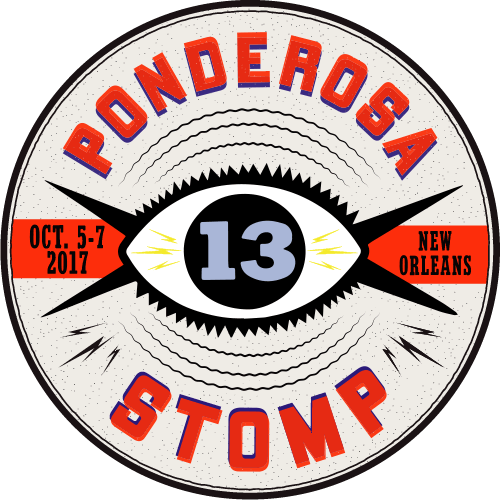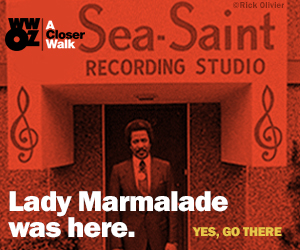
Louisiana vocal giant GG Shinn has delivered some of the most electrifying performances in recent Ponderosa Stomp memory. On Aug. 29, Shinn will be stepping up to an East Texas microphone to support his equally talented foil in the legendary 1960s lineup of the Boogie Kings, Jerry LaCroix, one of the most soulful voices in Gulf Coast music history. A benefit concert for LaCroix is scheduled from 3 p.m. to 8 p.m. at Crockett Street Entertainment District in Beaumont – part of Texas’ Golden Triangle, the fertile musical breeding ground that has spawned Stomp favorites such as Barbara Lynn, Clarence “Gatemouth” Brown, the Big Bopper, Janis Joplin, George Jones, and Edgar and Johnny Winter. Appearing with Shinn will be swamp-pop/soul stud TK Hulin; Port Arthur native Jivin’ Gene of “Breaking Up Is Hard to Do” fame; East Texan keyboardist Ken Marvel, one of modern swamp pop’s pre-eminent songwriters; Scott McGill; Gerry Mouton; West Bank-bred drummer Steve Adams; Larry Badon; Bilou Hulin; and a host of Boogie Kings alumni such as Parker James. The donation is $20, and barbecue and gumbo will be sold.
LaCroix singing under the name Jerry “Count” Jackson:

Jerry LaCroix was born in 1943 in Alexandria, La., lived in Jena, and moved to Texas’ Port Neches-Groves area as a youth. He played in a series of bands but sealed his stellar reputation by joining the Boogie Kings in 1965, performing as “Count Jackson” and joining Shinn in now-legendary, jaw-dropping duets as the “King Brothers.” LaCroix’s powerful, soul-belting voice served as a visceral counterpoint to Shinn’s silky-smooth, multi-octave acrobatics — all to the squealing delight of the bikini-clad throngs and their beaus at the Bamboo Hut in Galveston and other such storied venues.
Here is LaCroix and Duane Yates as the King Brothers at a Boogie Kings reunion doing one of the Boogie Kings few original numbers, The Philly Walk.
LaCroix recalls the first time he heard the Boogie Kings: “It was like a freight train coming through that room! These guys had five tenor saxophones, a couple of trumpets, a Hammond B-3 organ and one of those Louisiana drummers. They were playing all of that what is now called swamp pop music back then. Fats Domino, Bobby Charles, Louisiana-style music. These guys were really super powerful. They were great. So, after our band kind of disbanded, all of my friends went to the Berklee School of Music in Boston. So, I said if I can’t lick these guys I’ll join them. I called up Ned [Theall], the leader of the band, and asked him if he could use another singer. He said, ‘Come on.’ There were three lead singers and all the horn players sang like black chicks in a gospel choir. They had beautiful voices. It was just an incredible band.”
See LaCroix in a Boogie Kings reunion:
A multi-instrumentalist (sax, keyboards, guitar, and harmonica), LaCroix went on to perform, tour, and record with Edgar Winter’s White Trash band; Blood, Sweat, and Tears; and Rare Earth in the 1970s. He also cut two solo records, “LaCroix” and “Second Coming.”
LaCroix singing with Blood, Sweat, and Tears:
LaCroix singing backup and playing sax with Blood, Sweat, and Tears:

A regular performer at the Gulf Coast Music Hall of Fame’s annual Janis Joplin tribute concert, LaCroix’s bluesy, balls-to-the-wall vocal style likely influenced the young chanteuse from Port Arthur. “She used to come out to a club across the river and play. It was a place that was really famous down here called The Big Oaks Club in Louisiana just across the Sabine River. At that time, the drinking age in Texas was 21, but in Louisiana it was 18. If you could reach the bar with a quarter you could get a beer. They were very loose. In fact, I started playing over there when I was 14 years old. … I knew of her by reputation, but her reputation in this area wasn’t very good. She had a bad reputation because she talked bad about Port Arthur, but we still loved her.”

Joplin’s sister, Laura, confirms LaCroix’s influence in her biography, “Love, Janis,” and also paints a vivid portrait of that bustling time and place in Louisiana music history: “Vinton, Louisiana, offered Janis a glimpse into another way of life. It was Cajun. Both the language and the social attitude that came with it were different from the Anglo culture of Texas. There was a whole group of bars catering to the Texas youth: the Big Oak, Lou Ann’s, Buster’s, the Stateline, and more. Each had a large dance floor and several pool tables. After growing up glued to radio and hi-fi, Janis found her first good live music in Vinton. It may have been Cajun soul, rockabilly, or something else. There was certainly the white soul music of Jerry LaCroix and the Counts. Whatever it was, it sounded good, and uniquely Louisianan. Mixed into the atmosphere of the club was the Cajun priority of having a good time. These French-Acadian descendants didn’t harbor the pent-up Anglo-Saxon attitude toward emotional expression. They let it flow and everyone accepted it.”
According to journalist Margaret Moser: “For kids in East Texas’ ‘Golden Triangle’ — Beaumont, Port Arthur, and Orange — the promised land of booze and blues lay just across the Louisiana border. While the big-city sound of Bobby Bland and gritty rhythm of Lightnin’ Hopkins filtered in from Houston, 90 miles away, Slim Harpo, Clifton Chenier, and swamp-pop royalty like Tommy McLain, Rod Bernard, and Dale & Grace reigned in the roadhouses and dance halls of Cajun and swamp country that ran off Highway 90 between Lafayette and the Lone Star border.”
Come pass a good time — Golden Triangle style — and help support a true Texas-Louisiana music legend, Jerry “Count Jackson” LaCroix, in Beaumont on Aug. 29 at 3 p.m.
For a partial discography of LaCroix’s work, visit LaCroix’s web site




